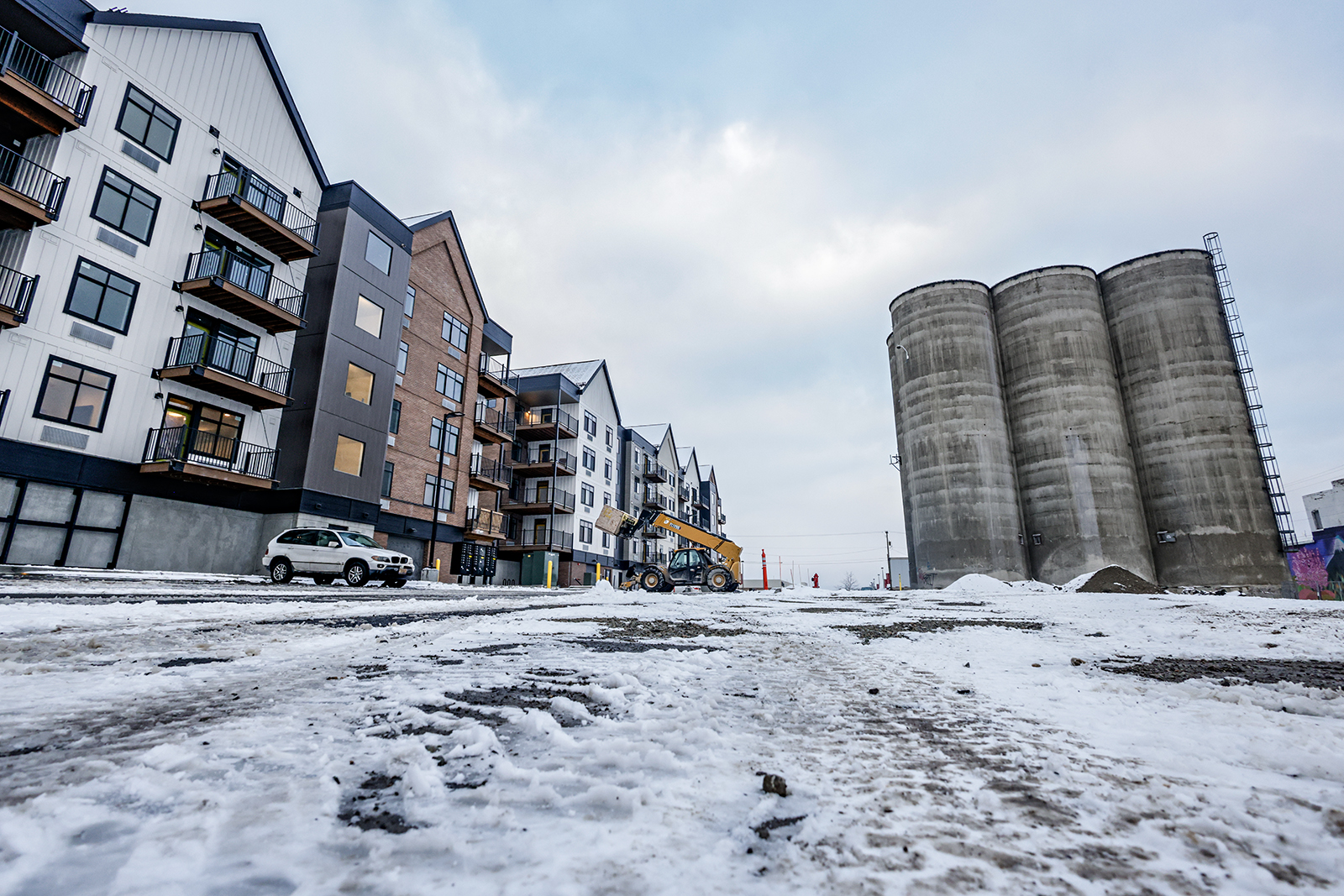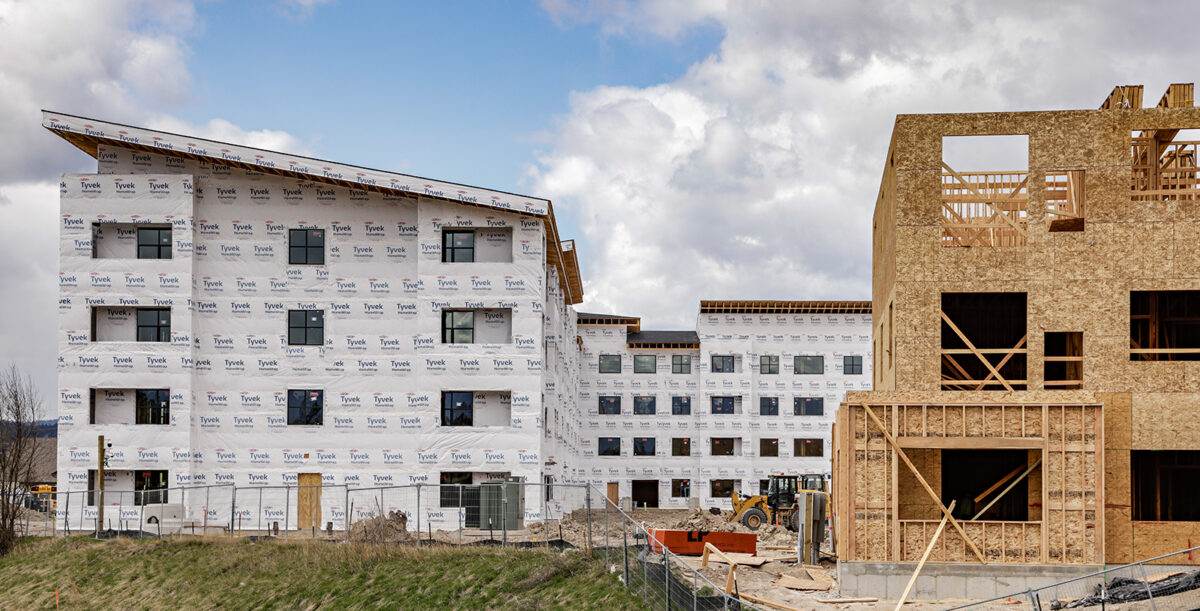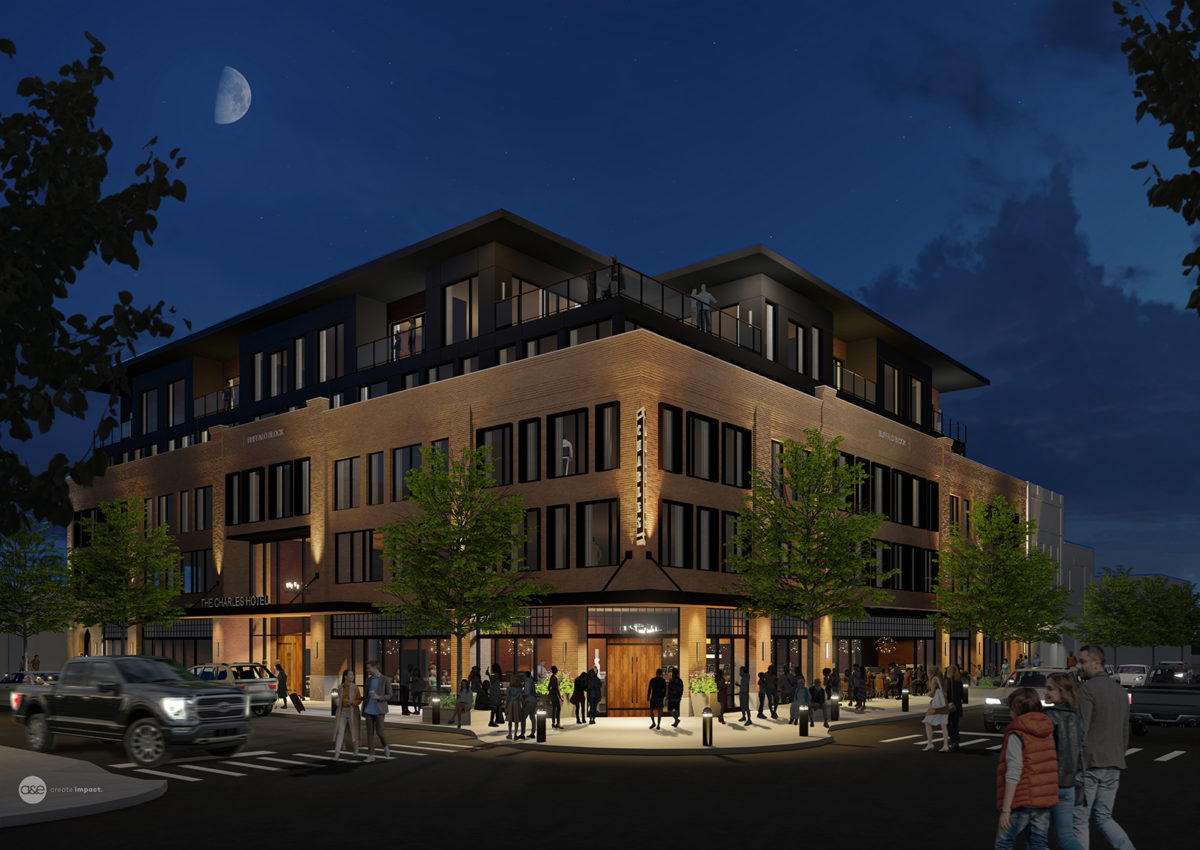Flathead Construction Chugs Along Despite Economic Challenges
Building remains strong in the Flathead Valley, even as projects continue to fall behind schedule while developers navigate high interest rates, expensive construction costs and labor shortages
By Maggie Dresser
Three years ago when local developer Mick Ruis unveiled his new project at the former CHS grain elevator property on Center Street and Fifth Street West in downtown Kalispell, he envisioned more than 200 residential units surrounding a restaurant he planned to perch on top of the historic 100-foot grain silo along the Parkline Trail.
Crews started moving dirt shortly after the project was announced and Ruis stockpiled building materials amid the height of supply chain shortages over the next few years. At the time, the developer known for his expansive projects in Whitefish and Columbia Falls, expected to finish The Silos by the end of 2022.
But by February of 2024, only the first phase was finished and 40 two-bedroom, two-bathroom apartment units were ready for tenants to move into. Now, the timeline for the remaining phases that will include offices, a gym, communal space and eventually the restaurant remains undetermined as Ruis works to complete the development.
The Silos project is just one example of many proposals that were formed during a period when the Flathead Valley saw a slew of new residents, interest rates dropped below 3% and construction demand had skyrocketed.
After things like supply chain and labor shortages delayed projects, many of those are now finally coming to fruition after years of holdups while others continue to sit idle.
Apartment complexes like the 224-unit Parkline Towers and another complex called The Landings on Two Mile Drive, both of which were announced in 2022, are now under construction and will bring hundreds of units online in the coming years.
In 2020, the City of Kalispell issued a peak total of 406 building permits followed by 300 permits in 2021. Permits have since declined and have hovered around 250 over the past two years, but building demand and activity remains strong, even as the cost of construction rises.

The total value of all construction peaked in 2021 at $160 million compared to $126 million in 2020, according to Kalispell’s 2023 annual report.
In Whitefish, the total construction valuation also peaked in 2021 at $140 million, according to Whitefish’s 2023 annual report. The year before, there were 302 new residential building units, 92 of which were single-family. By 2023, that number dropped to 63 total residential units.
While permit volumes and construction activity have slowed down since 2020, Kalispell Senior Planner PJ Sorensen says there’s still a high demand for multifamily developments as single-family permits drop off slightly.
“We’re down from what the peak was four years ago, but it’s still historically high,” Sorensen said.
In Kalispell, 229 single-family units came online 2021 compared to 102 single-family units last year.
“If you look way back historically, single-family was kind of the primary thing you saw built around here,” Sorensen said. “In terms of land and construction, apartments became a more affordable type of housing for people. So, I think you saw the market steer towards that because people couldn’t afford to get into the houses, but they could enter into the apartments.”
But with a saturation of multifamily proposals, Sorensen suspects that while high density complexes will likely remain dominant, the market could shift back to single-family building.
Sorensen said he spoke with one developer who had plans to build apartments on the southern end of the city and is now considering shifting to cottage-style homes on 3,000 square-foot lots.
Other developers, too, are forming proposals that include different housing types including townhouses, duplexes and rowhouses like the Spring Creek Park development, which the city council approved in 2022 and includes a mix of housing types ranging from single-family to rowhouses.
“We’ve seen the cottage (proposals), but we haven’t seen very many build out,” Sorensen said.
As more units start to come online years after proposals were approved, some larger projects like the Charles Hotel are facing more prolonged delays. Introduced in 2021 and approved by the city council in 2022, the public-private partnership is slated to bring multifamily housing units, a parking garage and a hotel and restaurant to downtown Kalispell.
While the unique partnership entails a public-private transfer of city-owned properties to developers as part of a tax increment financing (TIF) funding avenue, project partner Bill Goldberg is facing the same issues of interest rates, construction costs and labor as other contractors.
Goldberg now estimates the development to cost more than $80 million, nearly twice as much as the original estimation when it was introduced to the city in 2021.
The project initially involved a deadline that required Goldberg to start the project by March 31, 2024, but the council granted him more time in order to obtain capital from investment groups, who are hesitant to fund the project in the current economic climate.
“Things continued to slide on the timeline because of the lack of the ability to take the next steps with the funding to commit to signing a buy-sell with the city,” Goldberg said at the March 27 work session. “It wasn’t a stall tactic on my part, it was the reality that I didn’t want to take the next step without having the capital fully procured.”
“It’s a big shift,” Goldberg added. “It wasn’t for lack of trying and it wasn’t for lack of motivation for the project – it’s just the economic climate.”

David Smith, the executive director of the Montana Contractor’s Association, says similar challenges are causing backlogs of other commercial projects as financing becomes more difficult.
“Inflation has increased the material cost drastically and, at the same time, interest rates have gone up,” Smith said. “Instead of financing something at 4% or 5%, you’re at 6% or 7% – that’s a big deal. What’s happening is a lot of different projects that maybe somebody would be building an office building for a couple confirmed tenants, but 50% would be open to lease – those kinds of projects are being pulled back. It’s not a factor that’s affecting the daily work for contractors, but it’s affecting the backlog of future projects.”
At the University of Montana’s Bureau of Business and Economic Research (BBER), research economist Derek Sheehan attributes the economic climate to the “three L’s” – land, labor and loans.
“As land values go up, it’s harder and harder to build on that property and higher value homes make up those margins,” Sheehan said. “With loans – interest rates are high and it’s becoming harder to secure a loan … Some of those permits are just sitting there.”
Sheehan said labor remains tight in construction as the state’s unemployment rate continues to hover around 3%.
But according to the Montana Department of Industry and Labor (DLI), there were 38,200 construction jobs on the payroll in January 2024 compared to 31,000 in February 2020. While there are more laborers, construction jobs grew by 8.3% in 2022 and the DLI is projecting a need for 1,000 new construction jobs per year over the next decade.
“So, we’ve got this growth of 8,000 new jobs in the last four years, yet we need 1,000 more per year going forward,” Smith said.
Despite the economic challenges, Sorensen says the planning department in Kalispell continues to see project proposals from interested developers and, while building activity has slowed from its peak, the demand remains high.
“It’s ticked down, but it’s historically high,” Sorensen said. “You’re still seeing higher interest rates, you’re still seeing higher construction costs … but when you talk with developers – I think what they value more than anything is certainty. Knowing what the costs are going to be so they can make decisions.”